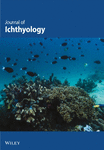Base and stressed ventilation rates for Leiostomus xanthurus Lacépède and Morone americana (Gmelin) exposed to strobe lights
Summary
A biomonitoring system interfaced with a microcomputer was used to monitor ventilation rates for white perch (Morone americana) and spot (Leiostomus xanthurus) under baseline and stressed conditions caused by strobe lights. Tests were conducted on light- and dark-acclimated specimens. These two estuarine species have been found to exhibit avoidance behavior to strobe lights. Potential accommodation to the strobe light stimulus was explored over a 24 h period. The biomonitoring system successfully recorded ventilation rates under baseline and stressed conditions. Baseline mean ventilation rates for 0.5 h intervals ranged from 1 count per minute (cpm) to 97 cpm for light-acclimated white perch with an overall mean for 24 h (x) of 41 cpm. Mean stressed rates ranged from 1 to 100 cpm with an overall mean of 44 cpm. Baseline rates for dark-acclimated white perch ranged from 1 to 79 cpm (x = 35 cpm), with stressed rates from 2 to 83 cpm (x = 30 cpm). Light-acclimated spot had baseline ventilation rates ranging from 3 to 146 cpm (x = 42 cpm), while stressed rates ranged from 2 to 134 cpm (x = 36 cpm). Mean baseline rates for dark-acclimated spot ranged from 1 to 94 cpm (x = 40 cpm), and stressed rates ranged from 1 to 72 cpm (x = 25 cpm). The difference in ventilation rates between base and stressed conditions (as absolute values) for light-acclimated white perch over the 24 h experiments ranged from 0 to 43 cpm (x = 11.01 cpm). Dark-acclimated white perch had differences ranging from 0 to 78 cpm (x = 11.13 cpm). Light-acclimated spot had differences ranging from 0 to 101 cpm (x = 14.68 cpm). Dark-acclimated spot had differences ranging from 0 to 70 cpm (x = 20.56 cpm). Ventilation rates varied between species and among individuals within a species. Ventilation rates were generally lower for dark-acclimated specimens. For both species under all conditions, the base and stressed rates were significantly (P < 0.05) different during the 24 h period. However, dark-acclimated specimens exhibited a more distinct difference than light-acclimated specimens. The lack of accommodation to strobe light and a stronger reaction under dark conditions indicate that strobe lights continue to offer potential as behavioral guidance systems for these species.




